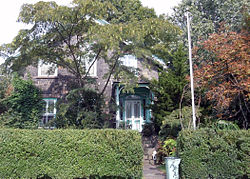United States historic place
| Dr. Samuel MacKenzie Elliott House | |
| U.S. National Register of Historic Places | |
| New York City Landmark No. 0338 | |
 The house in September 2012 The house in September 2012 | |
   | |
| Location | 69 Delafield Pl., Staten Island, New York |
|---|---|
| Coordinates | 40°38′38″N 74°6′37″W / 40.64389°N 74.11028°W / 40.64389; -74.11028 |
| Area | less than one acre |
| Architect | Dr. Samuel, MacKenzie Elliott |
| Architectural style | Gothic Cottage |
| NRHP reference No. | 80002757 |
| NYCL No. | 0338 |
| Significant dates | |
| Added to NRHP | March 28, 1980 |
| Designated NYCL | April 12, 1967 |
The Dr. Samuel MacKenzie Elliott House is a historic house located at 69 Delafield Place in West New Brighton, Staten Island, New York.
Description and history
Built in 1840, it was one of 22 similar houses in the area designed and built as investments by Scottish born Samuel Mackenzie Elliott, an oculist and eye surgeon who boasted prominent clients like John Jacob Astor, Peter Cooper, Henry Wadsworth Longfellow, and Horace Greeley. So great was his influence on the first settlement of this part of the north shore of Staten Island that the neighborhood was then known as "Elliotville". It is a 2+1⁄2-story, dark grey, locally quarried stone cottage in the Gothic style cottage. It has a gable roof with a small, pointed arch window under the rear gable.
Elliot was an active abolitionist, and this house, along with his own, was reputedly outfitted as a refuge for slaves escaping the United States via the Underground Railroad.
It was designated a New York City Landmark in 1967, and it was added to the National Register of Historic Places on March 28, 1980.
See also
- List of New York City Designated Landmarks in Staten Island
- National Register of Historic Places listings in Richmond County, New York
References
- ^ "National Register Information System". National Register of Historic Places. National Park Service. March 13, 2009.
- ^ "Landmarks Preservation Committee report" (PDF). 12 April 1967. Landmarks Preservation Committee. Retrieved July 3, 2011.
- "Cultural Resource Information System (CRIS)". New York State Office of Parks, Recreation and Historic Preservation. Archived from the original (Searchable database) on July 1, 2015. Retrieved April 1, 2016. Note: This includes Virginia Kurshan; Elizabeth Spencer-Ralph; Joan R. Olshansky (August 1979). "National Register of Historic Places Registration Form: Dr. Samuel MacKenzie Elliott House" (PDF). Retrieved April 1, 2016. and Accompanying four photographs
External links
| U.S. National Register of Historic Places in New York | ||
|---|---|---|
| Topics |   | |
| Lists by county |
| |
| Lists by city | ||
| Other lists |
| |
This article about a historic property or district in Staten Island, New York, that is listed on the National Register of Historic Places, is a stub. You can help Misplaced Pages by expanding it. |
This article about a building or structure in Staten Island is a stub. You can help Misplaced Pages by expanding it. |
- Houses on the National Register of Historic Places in Staten Island
- Gothic Revival architecture in New York City
- Houses completed in 1840
- New York City Designated Landmarks in Staten Island
- Underground Railroad in New York (state)
- African-American history in New York City
- West New Brighton, Staten Island
- New York City Registered Historic Place stubs
- Staten Island geography stubs
- Staten Island building and structure stubs